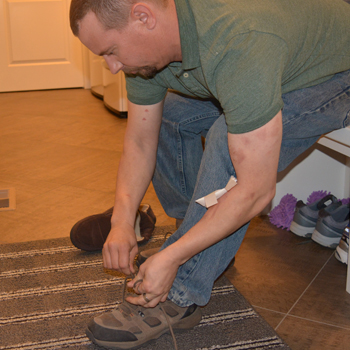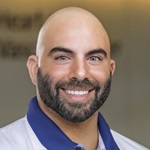Deep Brain Stimulation Surgery Gives Him His Life Back
 Brian Kattman would like to believe the last three years of his life were all just a bad dream. His struggles were all too real, however. Today, he’s filled with gratitude toward those who restored him to feeling the best he’s ever felt.
Brian Kattman would like to believe the last three years of his life were all just a bad dream. His struggles were all too real, however. Today, he’s filled with gratitude toward those who restored him to feeling the best he’s ever felt.
The trouble started with mild tremors in his left arm and hand. At first it was just an annoyance. The healthy 40-year-old Miamisburg resident thought the shaking would go away. He could still do his computer work for a large financial company. He could still drive himself to work and play some basketball with his friends.
Over a period of time, however, the shaking in his left arm grew worse, and his arm stiffened and curled up. At the same time, his left leg started dragging when he walked and shaking at rest. The shaking disrupted his sleep and his life. Brian became more self-conscious and more concerned.
“You don’t think about how much you use both hands at the same time,” Brian says. “It got harder to button up my shirt. Or tie my shoe strings. With both my arm and leg shaking, it became risky to drive.”
Watching her son’s condition rapidly get worse, his mom, Karen, encouraged Brian to get a checkup. He agreed and began a series of medical appointments and tests. After months of completing tests and blood work, he went to see a movement disorders specialist with the Clinical Neuroscience Institute. She named what the exams and tests revealed about Brian’s condition: “You have Parkinson’s disease.”
Karen recalls, “When she told Brian, he dropped his shoulders. You hear the words and you’re kind of numb. We thought, ‘What now?’ It’s scary; it’s new. You think he’s too young, but it can happen to anyone.”
Brian adds, “All I knew about Parkinson’s was that Michael J. Fox had it. We have no history of it in our family. The typical person doesn’t get this until their 50s or 60s. I thought, ‘I can’t have that.’”
Living with Parkinson’s Disease
Parkinson’s disease develops when degeneration occurs to an area of the brain called the substantia nigra, causing a reduced amount of dopamine, a neurotransmitter that helps with normal movement and other important neurochemical signaling. Brian's doctor recommended medications to help replace dopamine levels, along with regular exercise, shown to be neuroprotective in Parkinson’s. She prescribed Carbidopa/Levodopa, a pill that the body converts to dopamine. She also informed Brian about possible side effects and provided him with information on community resources and support groups.
At first, Brian was elated with the medicine’s ability to control his tremors. However, he experienced continued Parkinson’s symptoms over time and needed other medications to help manage them. Slowly, Brian began to experience motor fluctuations, alterations when a patient responds positively to medications. He felt that he was having more “off” time, with a reemergence of Parkinson’s symptoms, and so needed more medications to help him.
Eventually the medication side effects were becoming as bothersome as his tremors. He began to experience prominent dyskinesia — a movement disorder in which he’d move his head and face in abnormal ways — from peak dosages of the medications. The medications were not providing him with as much “on” time as he would like, with good control of his symptoms. In between medication doses, he was bothered by his tremors, slowness and rigidity. It was difficult to get used to taking medications all day long to move normally.
Brian had to leave his job with the financial company and took a new position that didn’t require interacting with the public.
“He could easily have stayed at home, but he felt good working,” Karen says. “He said he didn’t want to sit home thinking about all of this.”
Brian’s pills became a lifeline. He panicked if he left his home without them. Without a new dose every four hours, the extreme shaking in his arm and leg would return.
His doctor worked to fine-tune Brian’s medications. When he continued to have significant motor fluctuations and symptoms, she discussed the possibility of deep brain stimulation (DBS) surgery to reduce his need for medication and therefore lower the side effects.
Brain Surgery Offers New Hope
“At first, of course, I was afraid,” Brian recalls. “It’s brain surgery. I didn’t know if it would change me as a person.”
Supported by his girlfriend, Beth, his mom and his neurologist, Brian did some research on his own and evaluated his current quality of life. He then decided to proceed with testing that would determine if he were eligible for surgery. Brian also underwent psychological testing with neuropsychologist Fadi Tayim, PhD, director of the Brain Mapping Center at the Clinical Neuroscience Institute. In fact, Premier Health offers the first brain mapping center in the Midwest.
Once his doctors confirmed Brian as a good candidate for surgery, Brian made an appointment to see neurosurgeon Daniel Gaudin, MD, PhD, also with the Clinical Neuroscience Institute, after his treatment was discussed by the neuroscience multidisciplinary team.
“Dr. Gaudin is an amazing surgeon with a great personality, and he knew how to explain what I’d be going through,” Brian says. During his appointments, “Dr. Gaudin made me feel so much better every time I talked to him.”
Dr. Gaudin explains that DBS has been around for more than 20 years, and improvements during that time have increased the surgery’s ability to dramatically decrease Parkinson’s disease symptoms. With fewer symptoms, people can take less medication and have fewer side effects.
“We use the most modern, up-to-date technologies,” Dr. Gaudin says. “A week before the implantation, our patient will undergo a small procedure to place very small screws into the skull, then have a CT scan and MRI.” Those images are used by Dr. Gaudin, with highly advanced software, to create a 3-D model of the head and precisely target the sites for implantation of the leads.
During the implantation surgery, Dr. Gaudin precisely places one or two very small electrodes into the brain. To achieve optimal results from the electrodes, the patient is awake during this part of the procedure and can interact with Dr. Gaudin and the other highly specialized staff in the operating room.
On the day of Brian’s implantation surgery at Miami Valley Hospital, he was off his medications. His left arm and leg were shaking uncontrollably.
During the course of the surgery, something incredible happened: “I was sitting in a recliner chair with comfortable cushions,” Brian recalls. “My left leg was going a million miles a minute; then it just stopped. I looked down, and my leg wasn’t shaking.”
Dr. Gaudin’s precise placement of an electrode in Brian’s brain instantaneously halted the shaking in Brian’s arm and leg. Dr. Gaudin then implanted one additional electrode into the target on the other side of Brian’s brain to achieve tremor control for both sides of the body.
In a follow-up procedure, Brian had a small programmable battery surgically placed in his chest. It connects to the electrodes and provides stimulation to his brain to control his shaking. He adjusts the amount of stimulation with a remote device.
Appreciating Life
Three months after DBS surgery, Brian’s shaking has stopped. He takes only a fraction of the medicine he once took, so his side effects have disappeared, as well.
“I’ve never felt so good in my life,” he exclaims with delight. “I’ve always been happy, but right now I’m ecstatic.” He credits Beth — now his fiancée — and his mom for standing by him and supporting him.
He also has high praise for everyone who cared for him in the Clinical Neuroscience Institute and Miami Valley Hospital.
“The doctors are amazing. Everyone is very educated, and it’s amazing how much they care about their patients. Everyone at the hospital is so nice, from anesthesia to the nurses.”
No longer burdened by constant shaking, Brian is weighing his career options. He has resumed playing basketball and joined the local YMCA to increase his fitness. He’s even volunteered to talk with other patients about his positive experience with DBS.
Brian appreciates the small but important changes in his daily life. “People don’t stare at me like something is wrong anymore. I don’t have to run for my medicine just to make breakfast.”
He also feels the change on a much grander scale: “I have my life back!”


Contact Us
Our specialists are ready to help you get back to the things that matter most in your life. Find a provider near you or consult our list of related practices.
Our specialists are affiliated with:

